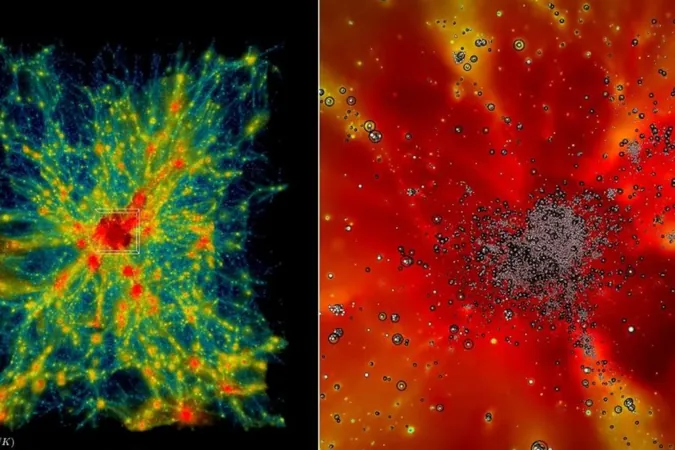
The Most Ambitious Universe Simulation: Supercomputer Frontier Tackles Cosmic Mysteries!
2024-12-07
Author: Yan
The Largest Universe Simulation Ever Recorded
In an astronomical breakthrough, a team of scientists has harnessed the power of Frontier, one of the world's most advanced supercomputers, to accomplish the largest simulation of the universe ever recorded. This monumental task involved grappling with the complexities of atomic and dark matter that comprise our cosmos.
Power of the Frontier Supercomputer
Frontier, renowned for its exascale capabilities, processed a staggering quintillion calculations each second. This formidable computational power allowed researchers to simulate astrophysical processes and conditions akin to those observed from the universe's largest telescopes—something previously unattainable.
Insights from Scientists
Salman Habib, director of computational sciences at Argonne National Laboratory, emphasized the importance of this endeavor: 'To understand the universe, we need to simulate a multitude of factors including gravity, hot gas, star formation, black holes, and galaxies—it's the entire ‘kitchen sink’ of astrophysics.'
Understanding the Universe's Content
Interestingly, the matter we can directly observe—ranging from black holes to planets—constitutes a mere 5% of the universe’s total content, with about 27% being dark matter, an elusive form of matter detectable only through its gravitational effects. The remaining 68%? That's the mysterious dark energy, which is driving the accelerated expansion of the universe.
Implications for Cosmic History
But what does this expansive simulation mean for our understanding of cosmic history? Habib notes, 'By simulating vast portions of the universe, such as those captured by the Rubin Observatory in Chile, we can look back through billions of years of cosmic expansion. Only recently have we had the computational power to realistically simulate such phenomena beyond mere gravitational approximations.'
Breathtaking Visual Results
The visual results of the simulation are nothing short of breathtaking, offering insights into the evolution of galaxies over billions of years. In the provided graphics, one image chronicles the universe's expansion and its intricate clusters of galaxies, while another illustrates the formation and motion of those galaxies—a testament to the detailed accuracy achieved through Frontier.
Significance of the Simulation
Bronson Messer, director of science at Oak Ridge Leadership Computing Facility, highlighted the simulation’s significance, noting, 'Not only does the sheer size of the simulation allow for direct comparison with modern observations, but it also incorporates a range of dynamic physical processes, enhancing its realism tremendously.'
Frontier's Role and Future Prospects
It's worth noting that Frontier is no longer the fastest supercomputer in the world; however, it remains a vital asset in the quest for cosmic knowledge. Housed at Oak Ridge National Laboratory, this powerhouse comprises over 9,400 CPUs and 37,000 GPUs, demonstrating the collaborative efforts of various institutions, including the Department of Energy.
Advanced Coding in Simulation
The recent successes were made possible through advanced coding known as the Hardware/Hybrid Accelerated Cosmology Code (HACC), upgraded as part of the Exascale Computing Project, a monumental $1.8 billion initiative by the DOE.
Future of Cosmic Exploration
This breakthrough simulation paves the way for future research and understanding of the universe, igniting curiosity and opening doors to questions about our place in the cosmos. What other secrets might the universe still hold? Stay tuned as scientists continue their cosmic exploration!
 Brasil (PT)
Brasil (PT)
 Canada (EN)
Canada (EN)
 Chile (ES)
Chile (ES)
 Česko (CS)
Česko (CS)
 대한민국 (KO)
대한민국 (KO)
 España (ES)
España (ES)
 France (FR)
France (FR)
 Hong Kong (EN)
Hong Kong (EN)
 Italia (IT)
Italia (IT)
 日本 (JA)
日本 (JA)
 Magyarország (HU)
Magyarország (HU)
 Norge (NO)
Norge (NO)
 Polska (PL)
Polska (PL)
 Schweiz (DE)
Schweiz (DE)
 Singapore (EN)
Singapore (EN)
 Sverige (SV)
Sverige (SV)
 Suomi (FI)
Suomi (FI)
 Türkiye (TR)
Türkiye (TR)
 الإمارات العربية المتحدة (AR)
الإمارات العربية المتحدة (AR)